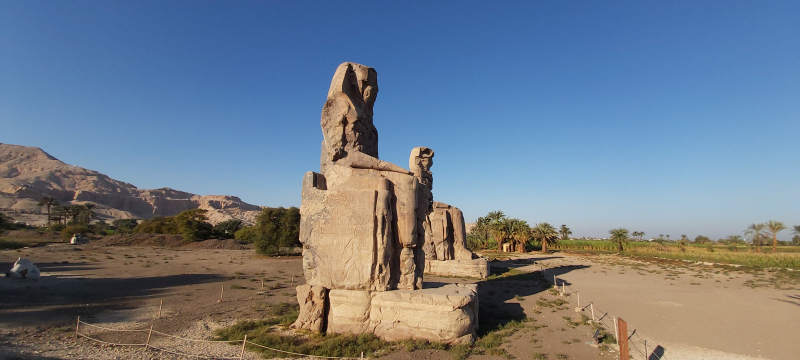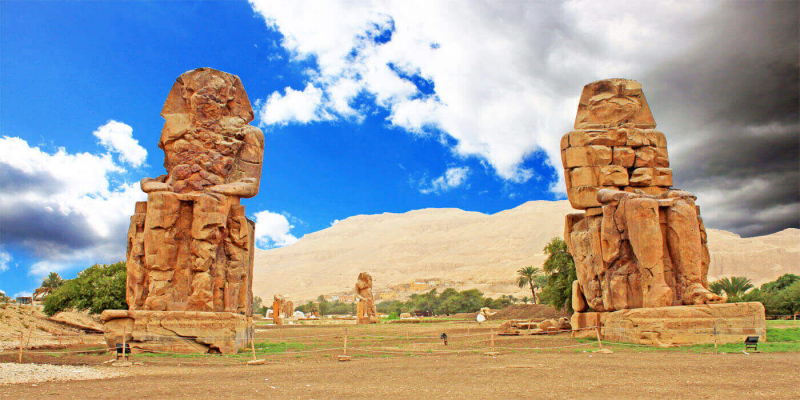
For thousands of years, the hulking stone figures of the Colossi of Memnon have been shrouded in mystery. Standing majestically in the Nile Valley, these two gargantuan statues were built by the ancient Egyptians in the 13th century BC, and are believed to have been erected in honor of the Pharaoh Amenhotep III. For centuries, these statues have been a source of fascination for historians, archaeologists, and treasure hunters alike, as they attempt to uncover the secrets and stories behind the Colossi of Memnon. From the inscriptions that adorn their bases to the tales of their magical powers, the mysteries of the Colossi of Memnon remain as captivating today as they did in ancient times.

Historical Context - Who Built the Colossi of Memnon?
The Colossi of Memnon were constructed by the ancient Egyptians in the 13th century BC, during the reign of Pharaoh Amenhotep III. The two statues are believed to be representations of Amenhotep himself, and are thought to have been erected in his honor. The statues are made from quartzite sandstone, and stand at a height of over 18 meters. They are the largest single statues ever created by the ancient Egyptians, and remain one of the most impressive and enduring monuments of ancient Egyptian art and architecture.
The statues are believed to have been created as part of Amenhotep's temple complex, and were likely intended to serve as guardians of the temple. The statues are also associated with the nearby remains of a palace, which is believed to have been built by Amenhotep III. While the exact purpose of the statues remains unknown, it is clear that they were of great importance to the ancient Egyptians, and were likely intended to serve as a symbol of the Pharaoh's power and influence.
The Colossi of Memnon derive their name from the figure of Memnon, a mythical king who was said to have been killed by Achilles during the Trojan War. According to legend, Memnon's mother, the goddess Eos, was so grief-stricken by her son's death that she wept tears of gold over his body. In honor of Memnon, the ancient Egyptians named the two statues after him, and believed that they were imbued with magical powers.
Archaeological Discoveries - What Archaeologists Found at the Site
Since their construction, the Colossi of Memnon have been the focus of numerous archaeological excavations. Archaeologists have uncovered a wealth of artifacts at the site, including pottery, jewelry, weapons, and figurines. These artifacts provide valuable insight into the lives of the ancient Egyptians, and help to illustrate the importance of the Colossi of Memnon to the culture of the time.
In addition to the artifacts, archaeologists have also uncovered inscriptions on the base of the statues. These inscriptions are believed to be the oldest written records in the world, and provide an invaluable glimpse into the lives and beliefs of the ancient Egyptians. These inscriptions tell of the gods and goddesses worshipped by the Egyptians, and provide insight into the religious beliefs of the time.
The inscriptions also provide a valuable record of Amenhotep III's reign, and provide evidence of his influence on the culture and architecture of ancient Egypt. These inscriptions are particularly interesting, as they provide a unique window into the history of the time, and help to shed light on the importance of the Colossi of Memnon to the ancient Egyptians.
Legends and Myths - Tales of Magic and Mystery
The Colossi of Memnon have been shrouded in mystery and legend since their construction. According to the ancient Egyptians, the statues were imbued with magical powers, and were said to bring luck to those who passed by them. It is believed that the statues were also associated with the afterlife, and that they served as a gateway between the living and the dead.
The statues also became associated with the mythical figure of Memnon, and were said to weep tears of gold at dawn. This legend was likely inspired by the inscriptions on the base of the statues, which were believed to be the tears of Eos. While this legend is likely nothing more than a myth, it serves as an enduring testament to the power and mystery of the Colossi of Memnon.
Cultural Significance - How the Colossi of Memnon Influenced Ancient Egypt
The Colossi of Memnon have had a profound impact on the culture and architecture of ancient Egypt. The statues are believed to have served as a symbol of the power and authority of Pharaoh Amenhotep III, and many of the other monuments in the area were likely inspired by the design and grandeur of the Colossi. The statues also served as an inspiration to other cultures, and became a source of awe and admiration for travelers and adventurers in the region.
The Colossi of Memnon also served as an important symbol of the Egyptian afterlife. The statues were believed to be associated with the gods and goddesses of the afterlife, and were believed to be a gateway to the spiritual world. This belief was likely inspired by the inscriptions on the base of the statues, which were believed to contain the secrets of the underworld. As such, the Colossi of Memnon were seen as a powerful symbol of the afterlife, and were likely intended to serve as a reminder of the importance of death and the afterlife in ancient Egyptian culture.
Preservation Efforts - The Monumental Task of Protecting the Colossi
The Colossi of Memnon have endured for centuries, but are now in danger of being lost to the ravages of time. The statues have suffered considerable damage over the years, and are in desperate need of preservation and protection. In recent years, considerable effort has been made to protect and preserve the Colossi of Memnon, with numerous conservation and restoration projects being undertaken to ensure the statues remain standing for future generations to admire.
The primary focus of these preservation efforts has been on the statues' stone surfaces, which are in danger of being eroded by the elements. In order to protect the statues from further damage, a number of techniques have been employed, including the use of protective coatings and the installation of a drainage system. Additionally, the statues have been regularly monitored for signs of wear and tear, and any damage that is found is quickly repaired before it can cause further harm.
Modern Appreciation - Exploring the Colossi of Memnon Today
The Colossi of Memnon remain a popular tourist destination today, and continue to captivate visitors with their grandeur and mystery. The statues are now protected by the Egyptian government, and are open to the public for exploration and appreciation. Visitors to the site can explore the statues up close, and are encouraged to take in the majesty of the Colossi of Memnon.
The site also contains a number of other attractions, including a museum and a café, which provide visitors with an opportunity to learn more about the history of the statues and the ancient Egyptians who created them. Additionally, the site is home to a number of educational programs, which are designed to teach visitors about the importance of the Colossi of Memnon and the culture of ancient Egypt.
Conservation Strategies - Ensuring the Preservation of the Colossi
The preservation and conservation of the Colossi of Memnon is of the utmost importance, and considerable effort has been made to ensure the statues remain standing for future generations. In order to achieve this, a number of conservation strategies have been employed. These include the use of protective coatings to protect the stone surfaces from the elements, the installation of a drainage system to prevent water damage, and the regular monitoring of the statues for signs of wear and tear.
Additionally, the Egyptian government has undertaken a number of initiatives to educate the public about the importance of the Colossi of Memnon, and to ensure the public is aware of the need to protect and preserve the statues. These initiatives include the establishment of educational programs to teach visitors about the history of the statues and their importance to the ancient Egyptians.
Conclusion - Uncovering the Secrets of the Colossi of Memnon
The Colossi of Memnon remain a source of fascination and mystery to this day. From the inscriptions on their bases to the tales of their magical powers, the mysteries of the Colossi of Memnon remain as captivating today as they did in ancient times. While the exact purpose of the statues remains unknown, it is clear that they were of great importance to the ancient Egyptians, and have had a profound influence on the culture and architecture of the region.
Today, the Colossi of Memnon can be found standing majestically in the Nile Valley, and are a popular destination for tourists and adventurers alike. With the help of conservation efforts and educational initiatives, the Colossi of Memnon are being preserved and protected for future generations to enjoy. As such, the secrets and stories of the Colossi of Memnon remain as captivating today as they did in ancient times.